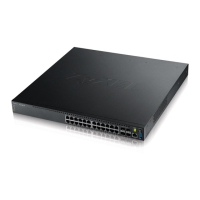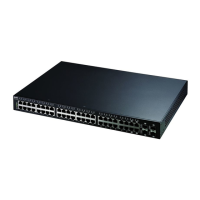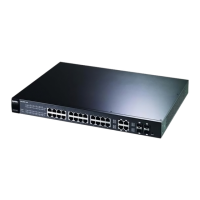Chapter 7 VLAN
GS3700/XGS3700 Series User’s Guide
105
7.5.2 VLAN Details
Use this screen to view detailed port settings and status of the VLAN group. See
Section 7.1 on
page 101 for more information on 802.1Q VLAN. Click on an index number in the VLAN Status
screen to display VLAN details.
Figure 64 Advanced Application > VLAN > VLAN Detail
The following table describes the labels in this screen.
Table 42 Advanced Application > VLAN > VLAN Detail
LABEL DESCRIPTION
VLAN Status Click this to go to the VLAN Status screen.
VID This is the VLAN identification number that was configured in the Static VLAN screen.
Slot ‘Slot’ refers to a Switch in the the ‘virtual chassis’ stack. This field displays the slot ID of
the stacked Switch.
Port Number This column displays the ports that are participating in a VLAN. A tagged port is marked as
T, an untagged port is marked as U and ports not participating in a VLAN are marked as “–
“.
Elapsed Time This field shows how long it has been since a normal VLAN was registered or a static VLAN
was set up.
Status This field shows how this VLAN was added to the Switch.
• Dynam ic - using GVRP
• Static - manually added as a normal VLAN
• Private - manually added as a private VLAN (primary, isolated or community)
• Voice - manually added as a Voice VLAN
• RMirror - manually added as a remote port mirroring VLAN
• MVR - added via Multicast VLAN Registration (MVR)
Private VLAN
Status
These fields show private VLAN information for the selected VLAN. See
Section 33.1 on
page 336
for more information on private VLANs.
Primary VLAN This field shows the primary VLAN ID in the selected VLAN.
Secondary
VLAN
This field shows the secondary VLAN I D in the selected VLAN.
Type This field shows the type of private VLAN: Prim ary, Comm unity or I solated.

